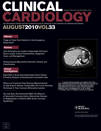Accuracy of Transthoracic Echocardiography for the Measurement of the Ascending Aorta: Comparison With Transesophageal Echocardiography
Abstract
Background
There has been a substantial increase in the number of imaging studies performed to assess thoracic aortic pathology. We sought to determine the accuracy of transthoracic echocardiography (TTE) compared to transesophageal echocardiography (TEE) for measuring ascending aortic size.
Hypothesis
Transthoracic echocardiography is reasonably accurate for assessing ascending aortic dimension.
Methods
Fifty-two patients with or without aortic disease underwent both TTE with nonstandard views and TEE. The ascending aorta was measured at 4 levels by 2 blinded observers for each modality. Pearson's correlation coefficients were determined and Bland-Altman plots and analyses were constructed. Inter- and intraobserver variability was determined in a random subgroup of patients.
Results
The mean age of the group was 65.5 years old and 15% had aortic dilation >4.0 cm. A strong positive correlation between the 2 imaging modalities was seen at all levels with the highest correlation for the maximum diameter of the ascending aorta (r = 0.936, P < 0.0001). Interobserver and intraobserver variability showed a good intraclass correlation among readers and among the same reader at all levels.
Conclusions
Transthoracic echocardiography using nonstandard imaging windows is accurate in comparison to TEE for measurement of the ascending aorta at multiple levels in patients with or without aortic pathology. The findings of this study provide support for selected serial follow-up of patients with aortic disease by TTE only. Copyright © 2008 Wiley Periodicals, Inc.
The authors have no funding, financial relationships, or conflicts of interest to disclose.




